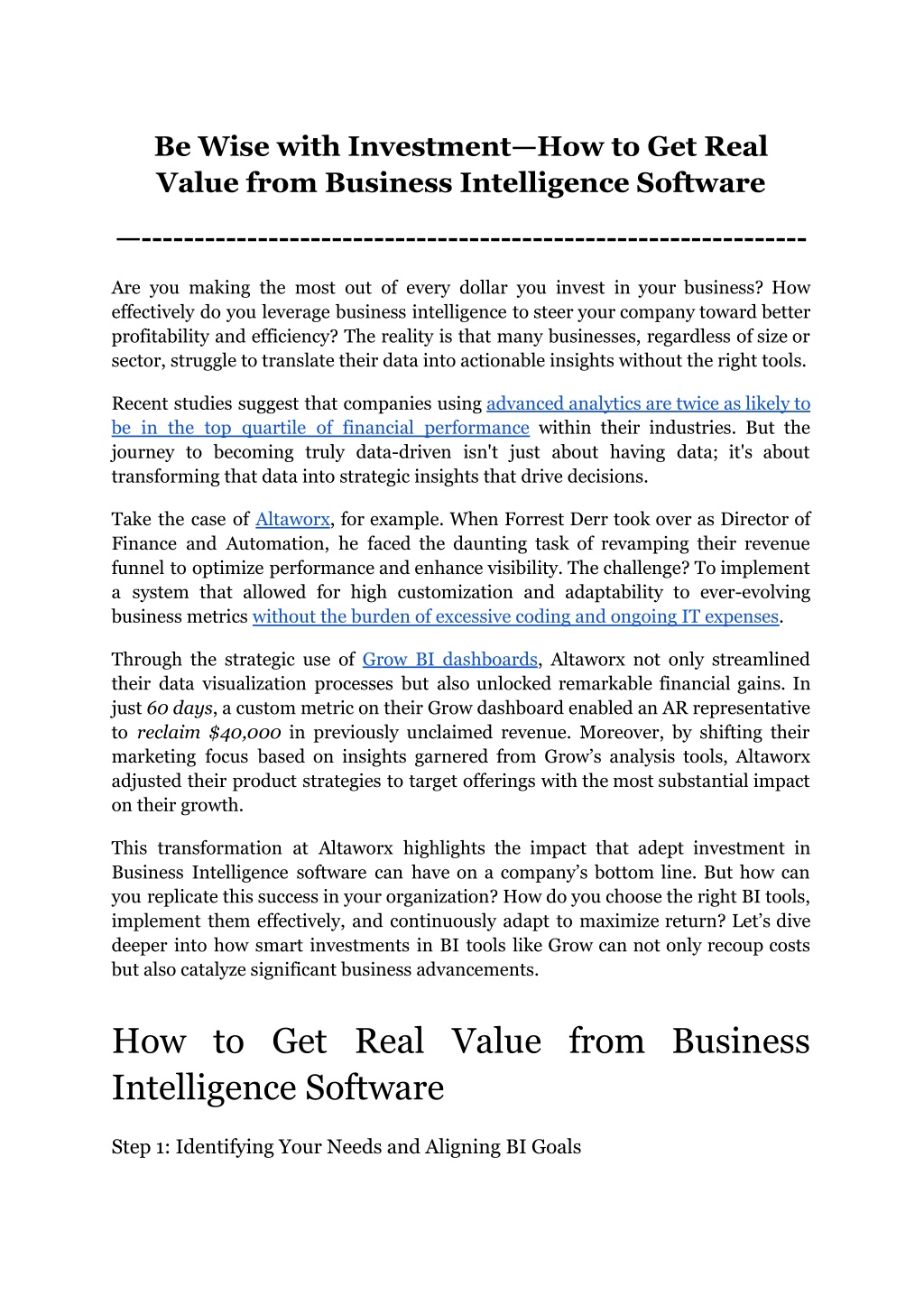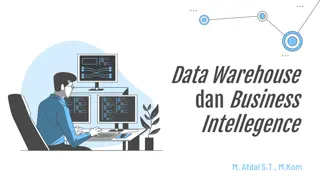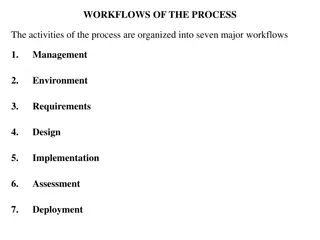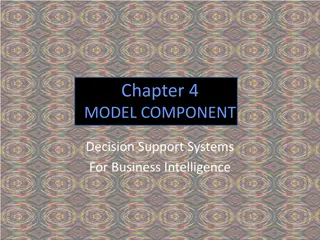
Be Wise with Investment—How to Get Real Value from Business Intelligence Software
Explore strategic ways to enhance your company's performance through smart investments in BI software tools. This blog provides essential insights into selecting, implementing, and optimizing BI software in the UK and other countries to improve decision-making, boost efficiency, and increase financial returns.
Download Presentation
Please find below an Image/Link to download the presentation.
The content on the website is provided AS IS for your information and personal use only. It may not be sold, licensed, or shared on other websites without obtaining consent from the author. Download presentation by click this link. If you encounter any issues during the download, it is possible that the publisher has removed the file from their server.
Presentation Transcript
Be Wise with InvestmentHow to Get Real Value from Business Intelligence Software --------------------------------------------------------------- Are you making the most out of every dollar you invest in your business? How effectively do you leverage business intelligence to steer your company toward better profitability and efficiency? The reality is that many businesses, regardless of size or sector, struggle to translate their data into actionable insights without the right tools. Recent studies suggest that companies using advanced analytics are twice as likely to be in the top quartile of financial performance within their industries. But the journey to becoming truly data-driven isn't just about having data; it's about transforming that data into strategic insights that drive decisions. Take the case of Altaworx, for example. When Forrest Derr took over as Director of Finance and Automation, he faced the daunting task of revamping their revenue funnel to optimize performance and enhance visibility. The challenge? To implement a system that allowed for high customization and adaptability to ever-evolving business metrics without the burden of excessive coding and ongoing IT expenses. Through the strategic use of Grow BI dashboards, Altaworx not only streamlined their data visualization processes but also unlocked remarkable financial gains. In just 60 days, a custom metric on their Grow dashboard enabled an AR representative to reclaim $40,000 in previously unclaimed revenue. Moreover, by shifting their marketing focus based on insights garnered from Grow s analysis tools, Altaworx adjusted their product strategies to target offerings with the most substantial impact on their growth. This transformation at Altaworx highlights the impact that adept investment in Business Intelligence software can have on a company s bottom line. But how can you replicate this success in your organization? How do you choose the right BI tools, implement them effectively, and continuously adapt to maximize return? Let s dive deeper into how smart investments in BI tools like Grow can not only recoup costs but also catalyze significant business advancements. How to Get Real Value from Business Intelligence Software Step 1: Identifying Your Needs and Aligning BI Goals
When it comes to maximizing the value of Business Intelligence (BI) software, the foundational step is to thoroughly identify your business needs and align them with clear, strategic BI goals. This not only ensures that your investment is justified but also that the BI tools you choose are effectively tailored to meet those specific business objectives. Understanding Business Needs Before exploring Business Intelligence software companies or tools, it s crucial to understand the specific needs of your business. This process involves a series of assessments to determine what you want to achieve with BI software. Are you looking to improve data visualization, enhance reporting capabilities, speed up decision-making, or monitor business performance in real time? Each goal will necessitate different features from BI software tools. 1. Conduct Stakeholder Interviews: Engage with various stakeholders across your organization to gather diverse perspectives on what they need from a BI tool. This could range from real-time data access for your marketing team to predictive analytics for your sales department. 2. Audit Existing Data Management Practices: Review your current data management systems. Are they fragmented or seamlessly integrated? Understanding this will guide you in choosing BI software in the UK or elsewhere that can either integrate with existing systems or replace them effectively. 3. Define Specific Use Cases: Identify and document specific scenarios or problems that the BI tool should address. This could include reducing the time to generate reports or gaining better insights into customer behaviors. Aligning BI Goals with Business Strategy Once you ve identified your needs, the next step is to align these with your overarching business strategy. This alignment ensures that the BI software tools you select contribute directly to your business's strategic objectives, thereby maximizing the ROI of your BI investment. 1. Set Measurable Objectives: Based on the needs you've identified, set clear and measurable objectives for what you expect to achieve with your BI software. For instance, if one of your goals is to enhance operational efficiency, define what that looks like in measurable terms, such as reducing report generation time by 30%. 2. Select Appropriate BI Software Tools: Choose BI software tools that best meet these objectives. Look for features that align with your goals, such as advanced analytics if you need to perform complex data analysis, or real-time capabilities if immediate data access is critical. 3. Plan for Scalability and Flexibility: Ensure that the BI software you choose can scale with your business and adapt to future needs. This is 2
especially important as the dynamics of business environments and technologies evolve. Step 2: Choosing the Right BI Software Types of BI Tools Business Intelligence software tools come in various forms, each designed to meet specific analytical needs of an organization. Understanding the different types of BI software tools can significantly influence their effective application. 1. Data Visualization Tools: These tools transform raw data into visually appealing formats, making complex data more accessible and understandable. Best-fit scenarios include instances where real-time decision-making is based on visual data trends. Companies like Tableau and Microsoft Power BI lead in this space, often recommended for their dynamic visualization capabilities. 2. Data Mining Tools: Designed for discovering patterns and relationships in large datasets, data mining tools are essential for predictive analytics. They are best suited for scenarios where businesses need to forecast trends and behaviors. Business Intelligence software companies that offer robust data mining functionalities help businesses anticipate market changes. 3. Reporting Tools: These tools allow for the generation of detailed reports that articulate the insights from data analyses. Ideal for regulatory and compliance scenarios, reporting tools are crucial in industries like finance and health care, where precise documentation is required. Features to Look For When evaluating BI software tools, certain features stand out as essential for deriving substantial value: 1. Scalability: The Business Intelligence software should grow with your business. Scalable solutions can handle increasing amounts of data and user load without degrading performance, crucial for expanding businesses in the UK and beyond. 2. Integration Capabilities: An effective BI tool must seamlessly integrate with existing systems and data sources within the organization. Integration reduces the complexities associated with data silos and enhances data accuracy and consistency across departments. 3. Real-Time Data Processing: The ability to process and analyze data in real-time is priceless. This feature supports immediate decision-making and offers a competitive edge by enabling businesses to respond swiftly to market dynamics. Cost vs. Value Analysis 3
Investing in BI software is a significant decision, and understanding the ROI involves looking beyond the initial costs: 1. Direct Benefits: These include increased efficiency, reduced time to insight, and lower operational costs due to automation of data processes. BI software tools can directly influence these areas by enhancing the speed and accuracy of data analysis. 2. Indirect Benefits: These are often overlooked but equally important. They include improved employee satisfaction due to easier access to information, better customer experiences informed by data-driven decisions, and long-term scalability and adaptability of business operations. 3. Evaluating ROI: To effectively evaluate the ROI of Business Intelligence software, businesses should consider both quantitative metrics like time saved and revenue generated, and qualitative benefits like improved data culture and decision-making confidence. Read: Do Grow's BI Tool Shows Its True ROI? When considering BI software in the UK or globally, it's essential to choose a tool that aligns with both your immediate needs and long-term strategy. Business Intelligence software companies that offer comprehensive solutions with these features can provide real value, ensuring your investment contributes directly to your business objectives. Step 3: Implementing BI for Maximum Return Effective Implementation Strategies The success of Business Intelligence software hinges not just on the technology itself but also on how it is implemented. Effective implementation strategies are critical for ensuring that BI software tools fully deliver on their potential. 1. Phased Roll-Out: Implementing BI software in stages can help manage the complexity of integration, allowing issues to be addressed incrementally. This approach minimizes disruptions in existing processes and helps maintain operational stability within UK businesses and others worldwide. 2. Stakeholder Engagement: Early and ongoing engagement of stakeholders ensures that the BI tool is aligned with the needs of all parts of the business. It s crucial that both management and end-users see the value in the new systems to foster a supportive environment. 3. Customization for Relevance: Each business has unique needs and challenges. Customizing the BI software to meet these specific requirements can greatly enhance the tool s effectiveness and ROI. BI software companies often provide flexible solutions that can be tailored to specific business processes. 4
Training and User Adoption A critical factor in realizing the value of Business Intelligence software is ensuring that the end-users can proficiently use the tools provided. Training and user adoption are, therefore important. 1. Comprehensive Training Programs: Developing comprehensive training programs that cater to various user competencies from beginners to advanced users is essential. Such programs should not only focus on how to use the software but also on how to interpret the data insights it provides. 2. Support Systems: Continuous support, including help desks, user manuals, and online resources, can aid in the smooth adoption of BI software in the UK and other regions. Business Intelligence software companies often offer ongoing support as part of their service package. 3. Feedback Mechanisms: Implementing mechanisms to gather user feedback on BI tools can provide insights into issues and resistance points, guiding further training and development efforts. Continuous Evaluation and Adaptation To stay competitive, companies must continuously assess and adapt their BI strategies based on performance metrics and evolving business needs. 1. Performance Metrics: Establishing clear metrics for evaluating the performance of BI software tools is crucial. These can include user engagement levels, speed of report generation, and the impact of insights on decision-making processes. 2. Regular Audits: Conducting regular audits of the BI system can help identify inefficiencies and bottlenecks, allowing for timely adjustments. These audits should review both the technical performance and user satisfaction. 3. Adaptability to Change: As business needs evolve, so should the BI tools. This adaptability can be facilitated by choosing BI software that is scalable and easily updated. In the UK, where many industries face rapid technological changes, this is particularly important. Conclusion Investing wisely in Business Intelligence software is central for any organization aiming to harness the power of data-driven decision-making. The right BI tools not only streamline processes but also unlock new opportunities and insights, fostering a culture of efficiency and innovation. As we've discussed, choosing the appropriate software, effectively implementing it, and continually adapting to changes are key steps to deriving maximum value from your BI investment. 5
At Grow, we understand these needs deeply. Our solutions are designed to integrate seamlessly into your business, providing scalable, user-friendly, and effective tools that evolve with you. Whether you're just starting out or looking to enhance existing capabilities, Grow's BI software stands ready to help you unlock the full potential of your data. We encourage you to explore how Grow can transform your business intelligence strategy. Sign up for a 14-day free trial and experience firsthand the benefits of our sophisticated yet intuitive BI tools. Don't just take our word for it; check out Grow Reviews from Verified Users on Capterra to see how other companies have thrived by choosing Grow. Make a wise investment in your business's future today. With Grow, you can harness the power of Business Intelligence and turn data into your most valuable asset. 6
















































